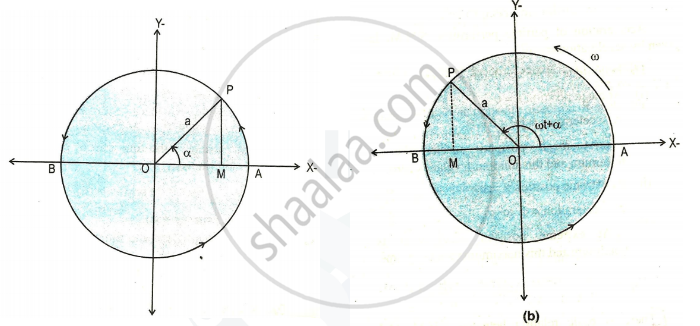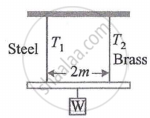Advertisements
Advertisements
प्रश्न
Show that a linear S.H.M. is the projection of a U.C.M. along any of its diameter.
उत्तर
Linear S.H.M. is defined as the linear periodic motion of a body in which the restoring force (or acceleration) is always directed towards the mean position, and its magnitude is directly proportional to the displacement from the mean position.
There is a basic relation between S.H.M. and U.C.M. that is very useful in understanding S.H.M. For an object performing U.C.M., the projection of its motion along any diameter of its path executes S.H.M.
Consider particle ‘P’ is moving along the circumference of a circle of radius ‘a’ with a constant angular speed of ω in an anticlockwise direction, as shown in the figure.
Particle P along the circumference of the circle has its projection particle on diameter AB at point M. Particle P is called a reference particle, and in the circle on which it moves, its projection moves back and forth along the horizontal diameter, AB.
The x-component of the displacement of P is always the same as the displacement of M, the x-component of the velocity of P is always the same as the velocity of M and the x-component of the acceleration of M.
Suppose that particle P starts from the initial position with initial phase α (angle between radius OP and the x-axis at the time t = 0). In time t, the angle between OP and x-aaxis is ( ωt + α ) as particle P moving with constant angular velocity (ω) as shown in figure.
cos( ωt + α ) = `x/a`
`therefore x=acos(omegat+alpha)` ......(1)
This is the expression for displacement of particle M at time t.
As the velocity of the particle is the time rate of change of displacement, then we have
`v=dx/dt=d/dt[acos(omegat+alpha)]`
`therefore v=-a omega sin(omegat+alpha)` ......(2)
As the acceleration of a particle is the time rate of change of velocity, we have
`a=(dv)/dt=d/dt [-a omega sin(omegat+alpha)]`
`therefore a=-aomega^2cos(omegat+alpha)`
`therefore a= -omega^2x`
It shows that the acceleration of particle M is directly proportional to its displacement, and its direction is opposite to that of displacement. Thus, particle M performs simple harmonic motion, but M is a projection of the particle performing U.C.M.; hence, S.H.M. is a projection of U.C.M. along the diameter of the circle.
APPEARS IN
संबंधित प्रश्न
Define linear simple harmonic motion.
Two parallel S.H.M.s represented by `"x"_1 = 5 sin(4π"t" + π//3)` cm and `"x"_2 = 3sin (4π"t" + π//4)` cm are superposed on a particle. Determine the amplitude and epoch of the resultant S.H.M.
What does the phase of π/2 indicate in linear S.H.M.?
Define linear S.H.M.
The equation of a simple harmonic motion is given by, x = 8 sin (8πt) + 6 cos (8πt), the initial phase angle is ______
In a spring-block system, length of the spring is increased by 5%. The time period will ____________.
A particle is performing a linear simple harmonic motion of amplitude 'A'. When it is midway between its mean and extreme position, the magnitudes of its velocity and acceleration are equal. What is the periodic time of the motion?
A particle executes simple harmonic motion and is located at x = a, b, and c at times t0, 2t0, and 3t0 respectively. The frequency of the oscillation is ______.
A particle is executing simple harmonic motion with frequency f. The frequency at which its kinetic energy changes into potential energy is ______.
For a particle executing simple harmonic motion, which of the following statements is NOT correct?
A simple pendulum performs simple harmonic motion about x = 0 with an amplitude A and time period T. The speed of the pendulum at x =A/2 will be ____________.
The velocities of a particle performing linear S.H.M are 0.13 m/s and 0.12 m/s, when it is at 0.12 m and 0.13 m from the mean position respectively. If the body starts from mean position, the equation of motion is ____________.
The graph between restoring force and time in case of S.H.M is ______.
A particle executes simple harmonic motion with amplitude 'A' and period 'T'. If it is halfway between mean position and extreme position, then its speed at that point is ______.
The equation of a particle executing simple harmonic motion is given by x = sin π `("t" + 1/3)` m. At t = 1s, the speed of particle will be ______. (Given π = 3.14)
Two simple harmonic motions are represented by the equations y1 = 0.1 sin `(100pi"t"+pi/3)` and y1 = 0.1 cos πt.
The phase difference of the velocity of particle 1 with respect to the velocity of particle 2 is ______.
For a particle executing SHM the displacement x is given by x = A cos ωt. Identify the graph which represents the variation of potential energy (P.E.) as a function of time t and displacement x.


A light rod of length 2m suspended from the ceiling horizontally by means of two vertical wires of equal length. A weight W is hung from a light rod as shown in figure.

The rod hung by means of a steel wire of cross-sectional area A1 = 0.1 cm2 and brass wire of cross-sectional area A2 = 0.2 cm2. To have equal stress in both wires, T1/T2 = ______.
For a particle performing linear S.H.M., its average speed over one oscillation is ______. (a = amplitude of S.H.M., n = frequency of oscillation)
If a body is executing simple harmonic motion, then ______.
Two simple harmonic motion are represented by the equations, y1 = 10 sin `(3pi"t"+pi/4)` and y2 = 5`(3sin3pi"t"+sqrt3cos3pi"t")`. Their amplitudes are in the ratio of ______.
What do you know about restoring force?
The displacement of a particle performing simple harmonic motion is `1/3` rd of its amplitude. What fraction of total energy will be its kinetic energy?
